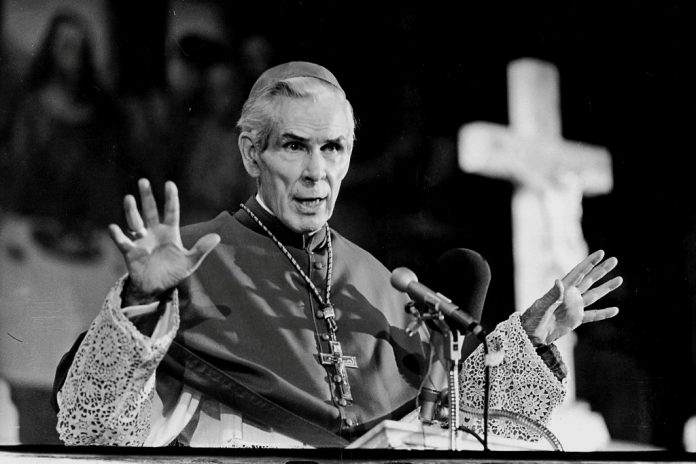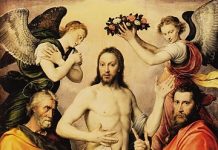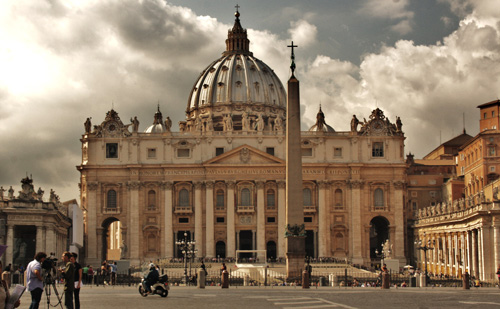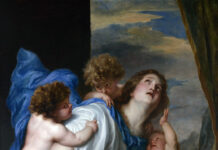Da per matrem me venire
Grant that I may come to Thee through Mary.
(Motto of Venerable Fulton J. Sheen)
The good people of Peoria Illinois are deeply disappointed. The beatification of one of their favourite sons — set for December 21 in this city’s Cathedral of Saint Mary of the Immaculate Conception on December 21 — has been put on hold. Which means the beloved archbishop will remain Venerable Fulton J. Sheen for awhile longer.
According to The Catholic News Agency (CNA), the reason provided by the Diocese of Peoria on December 3 was that several U.S. bishops had asked that Sheen’s cause be given more time for examination.
“With deep regret, Bishop Daniel Jenky, C.S.C, Bishop of Peoria, announces that he has been informed by the Holy See that the beatification of Fulton Sheen will be postponed,” said the press release from the diocese.
The diocese originally received word from the Vatican on November 18 that the beatification had been approved to take place this month. Then the diocese announced two days ago that “the Holy See decided to postpone the date of Beatification, at the request of a few members of the Bishop’s Conference who have asked for further consideration.”
“Bishop Jenky is deeply saddened by this decision,” said the press release. “In particular, Bishop Jenky is even more concerned for the many faithful who are devoted to Sheen and who will be affected by this news.”
Jenky is “firmly convinced of the great holiness” of Sheen, and “remains confident that Sheen will be beatified.” The cause for Sheen’s beatification and canonization will continue and, the press release continued, there have been “many miracles” reported through Sheen’s intercession, including some as recently as the last three weeks.
The Peoria diocese also stated explicitly that the delay was not the result of any allegations of abuse of a minor: “In our current climate, it is important for the faithful to know there has never been, nor is there now, any allegation against Sheen involving the abuse of a minor,” added the release. But neither was it revealed in the release which, or how many, bishops had requested the delay. Nor did the release state what prompted these requests.
The diocese said that throughout the investigation of Sheen’s life during the beatification process, “it has been demonstrated definitively that he was an exemplary model of Christian conduct and a model of leadership in the Church. At no time has his life of virtue ever been called into question.”
Sheen Centennial
On September 20, 1919, Fulton John Sheen had been ordained a priest of the Diocese of Peoria in the very cathedral where his beatification had been scheduled.
Born in El Paso, Illinois on May 8, 1895, and baptized at St.Mary’s Church four days later, Sheen was 24 when he was ordained a priest. From there, he went on to become a renowned theologian, a teacher of theology and philosophy at the Catholic University of America and also a parish priest. Then, beginning in 1928, as Father Sheen, he hosted The Catholic Hour, a nationally broadcast radio program on NBC which continued until 1950. And it wasn’t long before he became its most popular preacher, prompting an avalanche of letters and donations and putting him in high demand across the U.S. and at St. Patrick’s Cathedral in New York with which he was ever after associated. Then, as Monsignor Sheen, he moved to television where he presented his weekly half hour show Life is Worth Living (1952-1957) with stirring teachings, amusing stories and always with his signature sign-off, “God love you.” No surprise then that he quickly became a household name. And four years later, he repeated the format with his syndicated The Fulton Sheen Program (1961-1968). For this work, he was twice awarded with an Emmy for Most Outstanding Television Personality and featured on the cover of Time Magazine. And since 2009, his programs have been re-broadcast on EWTN and the Trinity Broadcasting cable networks where he is often cited as one of the first televangelists.
This comprised the public foreground of his continuously accomplished life. In the background was his work as auxiliary bishop of New York where he remained from 1951 until his appointment as Bishop of Rochester in 1966, a position he held until his resignation in 1969, after which he was appointed Archbishop of the titular see of Newport, Wales until his retirement three years later, when he moved back to New York City where he resided until his death on December 9, 1979 — 60 years after his ordination.
And what an exemplary sixty years they were. Packed with prayer, with the sacraments, with daily adoration before the Blesssed Sacrament and with the preaching that made him North America’s most beloved television catechist during the 1950s and 1960s when he reached an audience of millions every Sunday night.
Then there were his books. A full sixty-six of them, published between 1925 and 1980 when his autobiography, Treasure in Clay, was published posthumously. All packed with spiritual meat and all as relevant today as when first published. Perhaps even more so. Yet his book ministry was just one avenue of his intensely spirit-filled life, of which more later, and all leading to what is hoped will be his eventual canonization.
Beatification plans postponed
Plans for his beatification began officially on July 6 of this year with a decree from the Congregation for the Causes of Saints recognizing a miracle attributed to the archbishop’s intercession. The miracle involves the unexplained recovery of James Fulton Engstrom, a boy apparently stillborn in September 2010 to Bonnie and Travis Engstrom of the Peoria-area town of Goodfield. Which is when his mother, Bonnie, began praying intensely for the intercession of the venerable archbishop to save her baby son. Then, after 61 minutes with no heartbeat and doctors about to pronounce death, the baby suddenly and inexplicably returned to life, free of any damage that often results from such dire situations. Today, James Fulton Engstrom is just a normal 9-year-old boy. And his family, his doctors, his church and even Pope Francis agree — James received divine healing as an infant!
Yet even with this miracle, there had been a major glitch in Sheen’s case, complicated by a long legal dispute between the Archdiocese of New York and his closest living relative, his niece, Joan Cunningham Sheen. Since 2014, the Diocese of Peoria and Joan Cunningham Sheen had been arguing that her uncle’s remains should be transferred to the Illinois cathedral. But the Archdiocese of New York wanted to keep Sheen’s body in St. Patrick’s Cathedral. Eventually, after four appeals to keep Sheen’s body, the New York diocese relented and ton June 7, 2019, the New York Court of Appeals decided in Joan Sheen’s favour. This allowed the body of the famous broadcaster-priest to be disinterred and flown to Illinois for placement in a monument in Peoria’s Cathedral of St.Mary of the Immaculate Conception, opening the way for Sheen’s beatification to go forward.
Initially, however, Sheen’s case for sainthood did not look auspicious after the Archdiocese of New York refused to explore it in 2002. It was then the Peoria diocese took up Sheen’s cause. And by 2006, there was already testimony concerning two miracles alleged to have occurred through Sheen’s intercession and this was sent to Rome. But it wasn’t until 2012 that Pope Benedict XVI finally recognized the heroic virtues of the archbishop after the Vatican sifted through boxes and boxes of material on his life and ministry. Which is why it wasn’t until June 28, 2012, that the holy man whose extraordinary life — which spanned most of the 20th century on which he had commented so widely and so accurately — was declared ‘Venerable’.
Also noteworthy – because there are no accidents with the Lord — was that on that very special day, Sheen’s elevation to ‘venerable’ was shared by 154 martyrs of the Spanish civil war, the first front of the international war of ideologies — fascism and communism — that culminated in World War II. Ideologies on which Sheen had much to say. “The only difference between Hitler and Stalin is the size of their moustaches,” he told a large audience in Windsor, Ontario, in October 1939, a month after war had broken out. It was also Sheen, long an expert on socialism and communism, who accurately predicted months earlier that “those two gangsters” would inevitably unite to advance their evil agendas. Which they did with their treacherous non-aggression pact in August 1939, days before war broke out with the Nazi invasion of Poland. Sheen also warned repeatedly against the propaganda drive to make Russia appear as a bastion of religious freedom and called on U.S. president Franklin Roosevelt — whom he considered manipulative, superficial and naïve — to be “something more than a politician, to be a moral leader of the world.” Never shy, he also called Roosevelt “a liar” for claiming that the Catholic Church wanted the communists to win in Spain.
A Man of His Times
Yet this was just one aspect of the multi-faceted life that touched on so many other aspects of the 20th century. And just as time and eternity immutably intersect, Sheen was indeed a man of his times, a man whose life also uncannily mirrored that of the Roman Catholic Church before, during and after Vatican II and all its upheaval.
At the time, however, few were aware the seeds of that historic Council of the early 1960s had been planted a century earlier when the forces of modernism began to pressure the Church to shift her focus away from the internal formation of strong Catholic faith and character within her members, towards an outreach into the world, and with an emphasis on social issues such as the reduction of poverty, trade unionism and so on.
So it was into this climate, roiling just beneath the surface, that Fulton John Sheen was born, one of four highly intelligent sons of a devoutly Catholic family of hardworking farmers who encouraged Fulton to advance himself through virtue, voracious reading and a classical education. This meant that throughout his formative years, the Baltimore Catechism of 1884 was the foundation of his traditional Catholic belief, that membership in the One True Church was paramount for salvation. And the duty of every Catholic was saving souls.
A Rival Message Rising
Nevertheless, the rival message was rising apace — one that would ultimately tear the American church apart by asserting that Catholics were to have a social conscience that would shift their focus to the problems of the external world. This was a seductive idea that earlier popes had long seen developing, beginning with Pope Pius IX who condemned communism in 1864, three months after Karl Marx created the First International. Pope Leo XIII followed in 1878 with his encyclical against socialism, an ideology promising a Utopia that could never be. But that didn’t stop the founding of the American Socialist Party in 1901, an event that greatly troubled the American bishops. Why? Because all their repeated warnings were not dissuading or quieting the dissenting voices, including a handful of bishops, who argued that Holy Mother Church should adapt her doctrines to the new ideas of modern culture which, in their view, was progressing towards the Kingdom of God rather than the hell to which they were, in truth, destining their followers.
So no surprise that conflict would soon follow in the form of inexorable societal breakdown and war. As Thomas Reeves points out in America’s Bishop, his masterly biography of Sheen: “Out of this clash, liberal and conservative wings of the Church began to form, the one eager to be ‘in step’ with the popular culture, to get along with Protestants, to seek accommodation with the public schools; and the other stressing exclusivity and the supremacy of revealed and historic Catholic truths.”
And the virus was spreading. Just as a similar clash originating in France would give rise to “the Modernist controversy” a few years later, St. Joseph’s Seminary in Yonkers and Catholic University in Washington would follow suit, becoming American centres of the idea that, in light of ever-developing modern thought, the Church should re-examine her teachings, including the authority of the Magisterium.
A Century of Modernism
In 1907, Pope Pius X responded to this swelling movement with Pascendi Dominici Gregis decrying the doctrines of the Modernists and their efforts to transform Catholic theology by their pursuing a reign of terror against liberal scholars and clerics at all levels. The pope also required all priests and candidates for the priesthood to sign an ‘Anti-Modernist Oath’ to ensure the continuance of orthodoxy in an era when the Catholic standard throughout the Church was neo-Thomism, a view of God and the World as defined by 13th century theologian, St. Thomas Aquinas.
It was in this philosophical atmosphere that young Fulton grew up. Typical of the American Catholic family of pre-World War I, the Sheens attended Mass religiously and prayed the Rosary together nightly, while Fulton and his three brothers attended parochial schools where they excelled. Diminutive in stature, Fulton poured his enormous energy into becoming a skilled debater, noted for his beautiful speaking voice, penetrating eyes, charming personality and the fulsome academic preparation which served him so well throughout his life.
It was also understood from his earliest years that he would become a priest, a vocation which began formally at a seminary in St. Paul, Minnesota, and continued at the Catholic University of America in Washington where, as a Thomistic scholar, he earned a doctorate in philosophy. After ordination in 1919 and earning two degrees from CUA in 1920, Sheen attended the prestigious Louvain University in Belgium where he earned a second PhD in philosophy with highest distinction. From there, he was invited to try for a ‘super doctorate’, the agrege en Philosophie, making him the first American ever to receive such an offer. And, in 1925, Sheen earned the honour again with highest distinction, transforming his dissertation into a prize-winning book and winning the admiration of G.K. Chesterton, among others.
His successful European stint was then followed by a brief period as a curate in a poor church in Peoria, Illinois (a test given by his bishop to see if he would be obedient), before he became an instructor at Catholic University where he remained on the faculty, teaching philosophy and theology, from 1926 until 1950.
Which is when Francis Cardinal Spellman of New York appointed him to head the American branch of the Society for the Propagation of the Faith (SPF), the Church’s principal source of missionary funds. It was here that Sheen demonstrated his great skill as a fundraiser. The appointment also came with a mitre, leading to his consecration as bishop in 1951.
Public & Private Lives
During this fruitful period, Sheen continued to write books, articles, and newspaper columns at an astonishing rate. He accepted invitations to preach around the world. And he won countless converts, some famous — including writer Clare Boothe Luce, industrialist Henry Ford II, ex-Communists Louis Budenz and Bella Dodd. After Dodd rejected communism under Sheen’s conversion in the early 1950s, she became famous for announcing to the world that Moscow had spent many decades sending men to Catholic seminaries to damage the Church from within. Some of these men rose very high, she said. And in 1966, or ’67 she told theologian Dietrich von Hildebrand and his wife, Alice, that at least four were cardinals working in the Vatican, though Sheen forbade her to name them in public or in private, likely because he thought Miss Dodd’s life needed protection.
But these were just a few of his many converts, many of whom were lapsed Catholics such as the actress, Loretta Young, who he brought back to the faith. Unmentioned in the press were the thousands of Americans who came into the Church as a result of his powers of conversion, fuelled by daily prayer and his daily Holy Hour before the Blessed Sacrament, a practice he recommended to everyone who came into his orbit.
Thus, Sheen’s fame and reputation grew. So much so that when the Archdiocese of New York decided to enter the world of television in 1951, Sheen was the natural choice. His TV career began with a series of half-hour lectures broadcast opposite big budget shows such as that of Mr. Television, Milton Berle. But it didn’t take long for Life is Worth Living to take the country by storm, winning him an entry on the list of ‘most admired’ Americans. In 1955, his series moved to the ABC network where Sheen, still in his full purple, continued to deliver his talks with a blackboard and without notes opposite the hit quiz show You Bet Your Life, starring Groucho Marx and prompting Sheen to quip: “Viewers will now have the choice of two Marxes — Groucho or Karl.”
Keen to hear Christian answers to life’s problems, millions were captivated. And with his in-depth and highly critical views on Freudian psychoanalysis, then in its heyday, they were also keen to hear his opinions on Communism and the Second Red Scare sweeping the U.S. in the early 1950s. On this topic Sheen was consistent and insistent that with all ideologies, the loss of God always and everywhere meant the rise of tyranny. Nor, despite his deep concern with the plight of the worker and the poor, was he ever attracted to the Catholic Worker movement of Dorothy Day. “His firm grounding in the Christian doctrine of original sin and his strong views on socialism and communism left him without any worldly utopianism,” writes Reeves. “All efforts and plans to create heaven on earth, in his eyes, were sinful folly, detracting from the essential reason God placed man on this globe: to accept or reject God and His Son, to be judged accordingly, and to spend eternity in pure love or torment.”
The 1950s Turning Point
For his part, American pundit Pat Buchanan says he considers this prosperous period in which Sheen was such an icon as the apex of Roman Catholicism in the U.S.
But Reeves disagrees. In his view, the conventional wisdom within American Catholicism — that the Church sailed confidently through postwar prosperity only to be deliberately undermined in the 1960s by radical bishops, priests and nuns who hijacked Vatican II — is short-sighted. In Reeves’ view, the American Catholic culture epitomized by Sheen’s TV triumph was actually drawing its final breaths. By the end of the 1950s, traditional American Catholicism was already dying out … just as plans for Vatican II were ramping up.
But here again, Sheen’s life proved an accurate bellwether because by 1957 he was off the air, marking the beginning of his slide into the relative obscurity that would last until the end of his life.
As to the cause of this sudden downturn in the bishop’s fortunes, one was the wrath of Cardinal Spellman who saw to it that Sheen’s advancement was permanently thwarted, as were his Lenten speaking engagements in New York churches. The source of the cardinal’s ire? When Sheen refused to bow to his demand for SPF funds, the dispute took the pair all the way to Rome where Sheen’s decision was upheld, causing Spellman huge embarrassment before his fellow cardinals.
Still, the cardinal’s resulting rage did not defeat Sheen who then turned his energy towards Vatican II of which he was an enthusiastic, though always orthodox, supporter.
Did Sheen see the revolution ahead? Did he anticipate that an obsession with “social justice” would ravage the vineyard that once thrived on the strict spiritual formation of its members? Did he understand the warnings of Fatima would challenge the good will of the bishops and periti of Vatican II and the American Church whose influence dominated? Did he foresee that the errors of socialism, communism and human perfectibility — of which he had warned so eloquently and so repeatedly — were quietly permeating the doctrines and liturgy of the Church he so loved?
By 1960, the world was very different from the old one in which Catholic families enjoyed Church socials and laughed at the innocent problems of Ozzie and Harriet. By the late 1960s, the war in Vietnam was still raging, college students were displaying their lack of inhibition with “flower power” conformity, homosexuals were calling themselves “gay” and rebelling against the “straight” norm, prayer in the schools had been outlawed, feminists “liberated by the pill” were burning their bras and marching for the Equal Rights Amendment, New Left scholars were reinterpreting history through the prism of Marxism and pornography, rock music, drugs, free love, long hair and outlandish dress had become mainstays of the new culture.
And the Catholic Church in the U.S. was reflecting all this social upheaval which, within the Church itself, was traceable in large part to the intellectual elites who controlled seminaries and religious periodicals who were marching to the Left faster than the society at large and challenging its tradition, its authority and the basics of the Catholic faith itself.
The Locust Wake of the 1960s
In their locust wake, the liturgy and its magnificent music vanished; many old churches had been stripped of their tabernacles and kneelers and many of the new churches looked like gymnasiums designed by Soviet architects and populated by angry priests, monks and nuns who either left the Church or remained to work tirelessly to mold the Church into a vessel of the far Left, as they claimed — without convincing evidence — was intended by the Second Vatican Council. This while one Catholic university after another declared its independence from Catholic authority in the name of “freedom of conscience” and countless prominent Catholics proclaimed their opposition to Humanae Vitae of 1968.
These were the unintended fruits of the Council that had once so inspired Sheen’s earnest optimism. Yet his ultimate disappointment and displeasure were confirmed just as strongly in a range of public interviews he gave in which, as early as 1966, he was expressing his unhappiness with English translations of the Gospels, the new Mass and the Missal, which he considered as designed to please the least literate of Catholics. He also criticized the abandonment of religious habits and was appalled by the ultra-casual clothes now routinely seen at Mass. Neither did he have sympathy for the demand that women be priests. He also condemned the Supreme Court decision to legalize abortion on demand in 1973 via Roe v Wade.
Yet few things caused him more sorrow than the sight of those receiving Holy Communion without Confession of serious sin.
No Illusions
Even so, while Sheen had no illusions about the impact of ecclesiastical and social change, he remained optimistic that Holy Mother Church would cope, although, as he told Bill Moyers in 1973, he expected she would become smaller but more effective.
Four years later, however, Sheen conceded to Christianity Today that the Church was not as well off spiritually as she had been thirty years earlier: “Many feel that if they carry the banner for social justice, they need not be concerned about their personal morality.” He also lamented the drift into narcissism and the flight from reason and systematic philosophy, though he acknowledged that Thomism was no longer the exclusive approach to Catholic truth: “Today there is no reason why one should follow Aquinas more than Augustine. They are both viable and valuable.”
Nor, at 82, had his discernment waned as he dismissed Hans Kung as a 20th century Arian.
His deep faith, meanwhile, burned ever more fervently. Nearing death, the devout archbishop, who had long been regretting his early vanity, was now regarding anything not based in and on Jesus Christ as a total waste. Battling serious heart disease, Sheen nevertheless continued to travel, speak, and write without complaint, producing over the course of his more than 50-year Church career 66 books and countless articles, the royalties of which (more than $10 million) he donated almost exclusively to the SPF.
Final Years
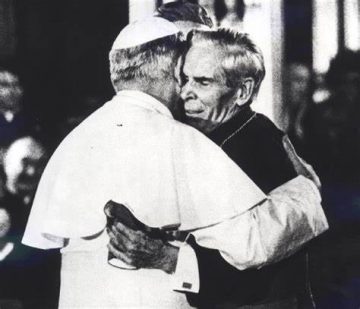 His deep faith, meanwhile, burned ever more fervently. Nearing death, the devout archbishop, who had long been regretting his early vanity, was now regarding anything not based in and on Jesus Christ as a total waste. Battling serious heart disease, Sheen nevertheless continued to travel, speak, and write without complaint, producing over the course of his more than 60-year Church career 66 books and countless articles, the royalties of which (more than $10 million) he donated almost exclusively to the SPF.
His deep faith, meanwhile, burned ever more fervently. Nearing death, the devout archbishop, who had long been regretting his early vanity, was now regarding anything not based in and on Jesus Christ as a total waste. Battling serious heart disease, Sheen nevertheless continued to travel, speak, and write without complaint, producing over the course of his more than 60-year Church career 66 books and countless articles, the royalties of which (more than $10 million) he donated almost exclusively to the SPF.
Finally, in October, 1979, Sheen met John Paul II in the sanctuary of St. Patrick’s Cathedral to thunderous applause — a moment he considered the zenith of his entire life, and buoyed further when the Pope told him privately that he had been a loyal son of the Church, perhaps the most delightful words the 84-year-old ever heard.
Sheen died weeks later — December 9 — in his chapel before the Blessed Sacrament, another witness to the graces that flowed from his perpetual prayer life which, in turn, made him the conduit of miracles that his priesthood became.
To the Venerable archbishop, the Gospel and the Church were the purpose of Man’s being.
As for what the Church meant to him, he said: “It is the Temple of Life in which I am a living stone; it is the Mystical Body of Christ on earth of which I am a member. The Church is therefore more to me than I am to myself. I consider sharing her life the greatest gift God has ever given to me, as I should consider losing her life the greatest evil that could befall me.”
And, until December 2nd, elevating the archbishop to “Blessed” as the second step in his official path to sainthood seemed reason to rejoice. Nevertheless, his fans just know this latest obstacle will prompt him to smile.
“God love them all,” he might say. Just as he so often said: “It’s all up to the Good Lord.”

